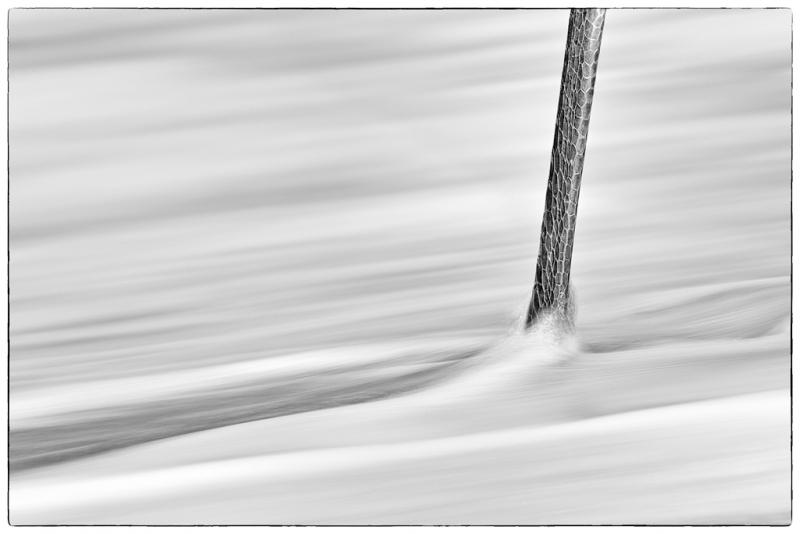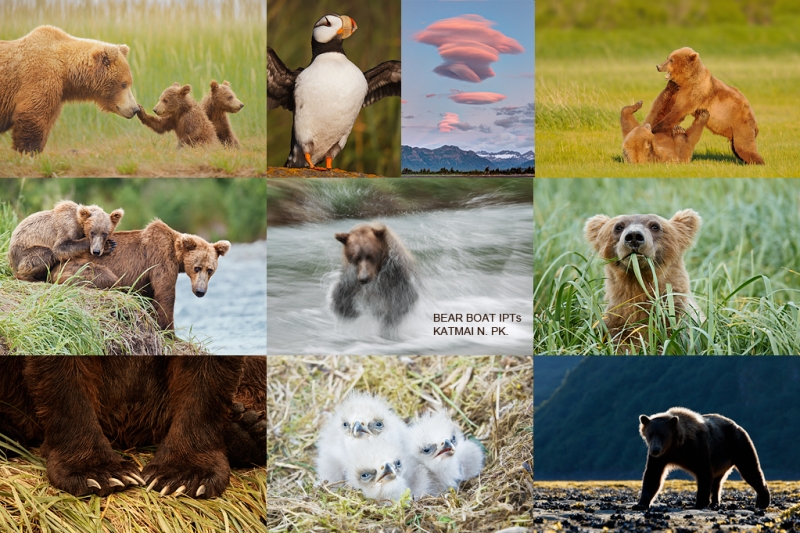|
This image, a pleasing blur of the sharply rendered leg of a tame Great Blue Heron, was created at Blind Pass Beach on the SW FLA IPT by Clemens van der Werf with the tripod-mounted Canon 800mm f/5.6L IS lens and the Canon EOS-1D Mark IV. ISO 50. Evaluative metering +1 2/3 stops: 1/15 sec. at f22 in Manual mode. Central Sensor/AI Servo Rear Focus on the bird’s leg and recompose. Click here if you missed the Rear Focus Tutorial. Click on the image to enjoy a larger, more spectacular version. Image copyright 2012 and courtesy of Clemens van der Werf. |
Teaching and Learning Creativity; A Great Example
As regular readers know, I am very proud of my friend and student Clemens van der Werf. Aside from being a super-nice guy Clemens is a mega-serious student of bird and nature photography. He has been on a zillion IPTs during the past two years. And he is headed back to Homer, AL today to join Robert O’Toole on another Bald Eagle trip, his second. Clemens’ work has been featured in several blog posts including Mystery Photographer and Skill Level Revealed, IPT Student Getting Too Good? Part I With Image Critiques, and IPT Student Getting Too Good? Part II With Image Critiques. The latter two posts feature 5 of Clemens’ best Bear Boat images with critiques on an additional 27. Studying good critiques is a great way to learn. If you are inspired to join me on the Bear Boat trip this July see item three below.
In Part I above I wrote, “The short story is that Clemens has been on virtually every IPT since attending the 2010 SW FLA IPT (now twice). He has been on the Homer IPT, the Bosque IPT (now twice), the San Diego IPT, the JBWR/Nickerson IPT, and most recently he attended the 2011 Bear Boat IPT. Prior to his first IPT he had photographed only sailboats, his dogs, and his daughter. His skills have improved steadily. The problem is that he is getting too good. His Coastal Brown Bear images from the recently concluded Photo-Cruise reflect continuing growth in all areas of his photography. His exposures are pretty much perfect, he has perfected his sharpness techniques, and he makes all the obvious images. But his biggest area of improvement has been in seeing and creating new and different images.
It was on the 2010 Bsoque IPT that Clemens was first exposed to blurs. The very talented Denise Ippolito was along. It was a slow morning. Just past the Chupadera Deck I stopped the group and got out with my Canon 70-200mm f/2.8L IS II lens, the 1.4X III TC, and the EOS-1D Mark IV. Everyone including Clemens looked at me like I was nuts. “There are no birds. Why are we stopping here?” My eye had been attracted to a tall stand of orange-red vegetation. I set a low ISO, picked a slow shutter speed in Tv Mode, added 1 1/3 stops of light, and began creating hand held vertical pan blurs. When I shared them on the back of the camera with the group–you gotta love the immediacy of digital capture–most folks joined in the fun. Denise also ledby example Before long most everyone was experimenting with pan blurs, zoom blurs, jiggle blurs, and flame blurs. Everyone including Clemens. And the look on his face made it clear that he was hooked on blurs.
That brings us to today’s image. Here once again the student has taken what he’s learned, applied it to a new situation, and created something very special. Clemens converted the image to black and white with NIK’s killer Silver Efex Pro plug-in. And he has entered it in the 2012 Veolia BBC Wildlife Photographer of the Year Competition in the Black and White category. Good luck Clemens! (It will not be long until Clemens garners his first BBC honors.)
If you’d like to learn to create pleasing blurs, check out A Guide to Pleasing Blurs by Denise Ippolito and yours truly. We cover dozens of different techniques that you can learn and use; Clemens’ image here is a moving water blur.
| [Not a valid template] |
TIME IS RUNNING OUT!
The deadline (March 31, 2012) for the BIRDS AS ART 1st International Bird Photography Competition is fast approaching. Enter now and get your images uploaded for a chance a the $22,000 worth of great prizes. And lots of prestige.
- Bird Portraits (images that show the whole bird)
- Tight Portraits and Body Parts (head shots, feather detail, and more)
- Flight (dramatic images of birds in flight)
- Small in the frame/Environmental (images of a bird or flocks of birds in their natural habitat)
- Pleasing Blurs (pleasingly blurred images of a bird or a flock of birds; images in this category must be created in-camera.)
- Action (Photographs of a bird or birds in action)
- Behavior (Images that exhibit interesting avian behavior)
- Hand of Man (the composition must include man-made elements)
- Digital Creations (anything goes including the use of filters and effects as long as there is a bird or birds in the image)
- Youth (images submitted by young photographers born on or after March 31, 1994)
- Captive including zoos (photographs of captive, zoo, pet, or rehab birds)
SELECTED IPT INFO
|
Join me this summer and live on a boat for six full and two half days of Coastal Brown (Grizzly) Bear photography. At close range. Live your dream. Great food too! Images copyright Arthur Morris & Robert O’Toole. If you are seriously interested please e-mail for itinerary and additional details. |
KATMAI BEAR BOAT IPT: July 24-31, 2012 from Kodiak, AK: $6699. Limit 6/Openings 3. Coastal Brown Bears (Grizzlies) Galore!
Coastal Brown Bears at point blank range foraging & clamming with a good chance of copulations; cubs nursing and playing. Likely additional subjects include Horned and Tufted Puffins, nesting Bald Eagle and Black-legged Kittiwake, Steller’s Sea Lion, rafts of Sea Otters and more. Halibut fishing optional.
BOSQUE del APACHE 2012 IPT: “The Complete Bosque Experience.” NOV 21-27, 2012. 7-FULL DAYS: $3399. Introductory Slide program: 6:30 pm on 11/20. Limit: 12/Openings: 10/Openings 8.
Tens of thousand of Snow Geese, 10,000 Sandhill Cranes, ducks including point-blank American Wigeon and Wood Duck, amazing sunrises, sunsets, and blast-offs. Live, eat, and breathe photography with one of (if not the) world’s premier photographic educators at one of his very favorite locations on the planet. Top-notch Photoshop instruction. This will make 18 consecutive Novembers at Bosque for me. Nobody knows the place better than I do. Join us to learn to think like a pro, to recognize situations and to anticipate them based on the weather, especially the light and the wind direction. Every time we make a move we will let you know why. When you head home applying what you learned will prove to be invaluable.
Earn Free Contest Entries and Support both the Bulletins and the Blog by making all your B & H purchases here.
More and more folks are earning multiple contest entries with their B & H purchases. See here for details on that. Eleven great categories, 34 winning and honored images, and prize pools valued in excess of $20,000. Click here to visit the competition home page.
Shopper’s Guide
Below is a list of gear that I used to create the image in this blog post. Thanks a stack to all who have used the Shopper’s Guide links to purchase their gear as a thank you for all the free information that we bring you on the Blog and in the Bulletins. Before you purchase anything be sure to check out the advice in our Shopper’s Guide.
Canon 800mm f/5.L IS lens. Right now this is my all time favorite super-telephoto lens.
Canon EOS-1D Mark IV professional digital camera body. My two Mark IVs are my workhorse digital camera bodies.
And from the BAA On-line Store:
LensCoats. I have a LensCoat on each of my big lenses to protect them from nicks and thus increase their re-sales value. All my big lens LensCoat stuff is in Hardwood Snow pattern.
LegCoat Tripod Leg Covers. I have four tripods active and each has a Hardwood Snow LegCoat on it to help prevent further damage to my tender shoulders 🙂 And you will love them in mega-cold weather….
Gitzo GT3530LS Tripod. This one will last you a lifetime.
Mongoose M3.6 Tripod Head. Right now this is the best tripod head around for use with lenses that weigh less than 9 pounds. For heavier lenses, check out the Wimberley V2 head.
CR-80 Replacement Foot for Canon 800. When using the 800 on a Mongoose as I do, replacing the lens foot with this accessory lets the lens sit like a dog whether pointed up or down and prevents wind-blown spinning of your lens on breezy days by centering the lens directly over the tripod.
Double Bubble Level. You will find one in my camera’s hot shoe whenever I am not using flash.
The Lens Align Mark II. I use the Lens Align Mark II pretty much religiously to micro-adjust all of my gear an average of once a month and always before a major trip. Enjoy our free comprehensive tutorial here.
Canon EOS-1D Mark IV User’s Guide. Learn to use your Mark IV the way that I use mine. Also available for the 7D and the Mark III here.
BreezeBrowser. I do not see how any digital photographer can exist without this program.
















The Heron’s leg and blurr is super fun, and actually a viable image. My first thought was ‘fun’, but my second was, “Now there’s a great pointer to the link between birds and their prehistoric reptile ancestors!”
Clemens’ image is fantastic. Really great vision to see and successfully execute the shot. Well done.